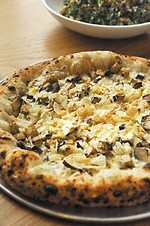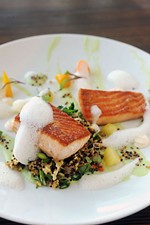Martha Knows Best?
Current Trends in Wedding Cakes
By Virginia B. Wood, Fri., May 9, 1997
|
|
As often as not, a wedding cake is much more a visual fantasy object than an actual food item. But creating this most identifiable symbol of the wedding celebration -- the piece de resistance confection for a once-in-a-lifetime event -- is still a stressful responsibility. Making wedding cakes requires skill, steady hands, and a fair amount of patience. It also calls for an appreciation of current trends, and deft communication to assure the bride gets exactly what she wants. Personally, I'd rather take a beating with a lead pipe than ever make another one. But now that I'm officially out of the business, I'm delighted to consider the history, traditions, and recent fads regarding these nuptial centerpieces. And wedding cakes as an intellectual exercise no longer keep me awake at night.
Since ancient times, the serving and consumption of cakes has been associated with all rites of passage, especially marriages. Wedding cakes symbolize both luck and abundance. The Roman custom of joining couples with a grain cake was carried to Europe, and for hundreds of years after, bridal couples were sprinkled with the crumbs of cakes as they crossed their thresholds to insure future bounty. The forerunners of the kind of wedding cakes we know today appeared in Europe in the mid 18th century. By this time the tradition had transformed; the cake was supposed to be large enough to insure each guest a piece, with enough left over for them to take another small slice to place under their pillows for luck. Baking technology being what it was in the 18th century, (i.e. wood fired ovens, unreliable leavening agents, limited food storage) the first modern wedding cakes were fruitcakes. They were dark, dense, unleavened cakes full of nutmeats and candied fruits, soaked in liqueurs, and covered with marzipan (almond paste) or rolled fondant, a smooth elastic paste of confectioner's sugar, water, gelatin, glycerine, and glucose. The marzipan or fondant coverings sealed the cake, allowing it to ripen in flavor and remain fresh until the wedding feast. The smooth covering also presented a clean palette for decoration and it was during the next hundred years that pastry cooks developed techniques of decorating cakes with fancy edible sugar artwork.
The decorating and ornamentation of wedding cakes reached a zenith in Europe during the Victorian age. At this point, the symbolic wedding confection also became a fantasy work of art. In England, fruit cakes covered in rolled fondant have remained a popular choice to this day. Here in America, however, 20th-century refinements in baking and storage methods, equipment, and ingredients popularized fresher, lighter layer cakes in more varied styles and flavors. Solid vegetable shortening mixed with powdered sugar and flavorings became the most popular decorating frosting. It holds its shape well when piped through a pastry bag, and is less likely to melt than fragile authentic buttercream frosting made with butter, egg yolks, and syrup. Modern cake surfaces are bedecked with borders and flowers piped from tinted frosting, or more difficult porcelain-looking flowers molded of gum paste (a mixture of sugar and gum tragacanth) and then topped, of course, with a porcelain or plastic bride and groom. Variations on this American style of wedding cake are pictured in the yearbooks published by the Wilton Company, the definitive authority on cake decorating and the purveyors of a complete line of cake baking/decorating paraphernalia for nearly 70 years.
Dewey McKinley Wilton and his wife made their reputation in Chicago by creating wedding cakes for famous hotels and clubs during the 1930s. The thriving business then turned into a cake decorating and candymaking school for caterers and chefs, popularizing their methods and equipment line through one of the nation's top department store chains at the time, JC Penney. The reputation of their school and the exposure gained by their association with a mass-market retailer enabled the Wiltons to build a decorating empire that influenced wedding cake tastes and trends for a long time to come. The Wilton method teaches that wedding cake layers be made with cake mixes; the frosting recipes are based on solid vegetable shortening. Their influence on decorating trends was unparalleled until the 1980s when the cooking and lifestyle publications of an upscale East Coast caterer named Martha Stewart took the country by storm.
Martha Stewart's current media empire grew out of her successful Connecticut catering business. Her first articles and books dealt with party foods and general entertaining but with the publication of 1982's Martha Stewart's Entertaining (now out of print) and the 1987 landmark Martha Stewart's Weddings, Stewart began to have a major impact on every aspect of wedding style in America, including cakes. While professionals sometimes complain about the authenticity and reliability of Stewart's recipes, there is no denying her influence. She advocates cakes that taste as wonderful as they look, made-from-scratch cakes in interesting flavors. Many of the cakes pictured in those books are frosted in a basket-weave frosting pattern and decorated with fresh flowers. The text suggests that fresh flowers for the cake can be chosen to complement the bride's bouquet or other wedding flowers and can be arranged on the cake by either the caterer or the florist. These books have inspired thousands of caterers and brides to switch to fresh flowers for cake adornments, the first really new decorating style in years.
These days, Stewart wields even greater power over trends through her syndicated television program and her magazine, Martha Stewart Living. The annual wedding issue of the magazine includes a section on cakes, complete with recipes. In the last few years, the featured cakes have been covered with rolled fondant icing, resurrecting that European style that hasn't seen much use in this country. Stewart points out that fondant offers a smooth palette for decorating, isn't subject to melting in summer heat, and keeps cakes fresher longer. All of these things are true. What she neglects to mention is that fondant is difficult to make, isn't particularly easy to work with, and tastes like sweetened chalk. It certainly doesn't taste like authentic buttercream and isn't even as palatable as the standard Wilton frosting recipe. The cakes in the magazine are very stylized and lovely, perhaps the perfect choice for the bride who is only concerned with visual presentation. And though style-meister Martha would have brides believe that fondant-covered cakes are a snap, finding a cake provider in Austin willing to make one won't be quite so easy.
A survey of Austin bakers, caterers, and pastry chefs revealed that there are very few people who will enthusiastically provide fondant-covered cakes. Most of the wedding professionals interviewed agreed that fondant tastes terrible and said that while they always try to please potential customers, they discouraged brides from choosing it whenever possible. "When brides bring a copy of the Martha Stewart magazine and insist," says Assorted Affairs Catering co-owner Carol Buchanan, "I tell them we just don't do them and suggest they get their cake somewhere else." Bakery owners Valerie Schuster of Upper Crust, Patricia Bauer-Slate of Sweetish Hill, and Judy Wilcott of Texas French Bread all concurred that their shops don't do fondant cakes because of the unappealing taste. However, due to the volume of requests for the fondant covering, a few local bakers and businesses are venturing into offering the service. A glance at advertisements in the yellow pages and local brides magazines reveals there are a few businesses promoting the fact that they will do fondant frosting. At this point, the market still appears to be wide open for a baker or cake designer who specializes in fondant and could provide reliable service to caterers and wedding facilities. The venerable Wilton company and a newcomer called Sweet Art Galleries of Indianapolis will gladly lend a hand.
In response to the growing demand for fondant covered cakes, Wilton now sells ready-made fondant through the network of retailers who carry their product line. One pound of Wilton fondant costs about $6 and will cover one eight-inch cake layer. While the product is consistent and easy to use, I still maintain that the end result will taste like cake coated with chalk candy. The newest, best tasting solution to this dilemma appears to be a product called Choco-Pan from Sweet Art Galleries. The chocolate fondant actually includes cocoa butter, is kneaded and rolled out just like regular fondant. It has a much better flavor without the chalky mouth-feel and provides the same smooth, porcelain-like surface for decorating. Until recently, Choco-Pan was only available wholesale to the baking trade but it is now available through one local retailer. Four-pound tubs of the four Choco-Pan flavors (wedding white, blanc, caramel, and noir) sell for $28 per tub at Miss Janette's Cake, Cookie & Candy Supplies. Owner Janette Pfertner is very enthusiastic about Choco-Pan, describing it as "the next big thing" in the cake decorating trade.
Be that as it may, my cake decorating days are still over. The first wedding cakes I remember were made with commercial cake mixes and covered with pounds of Crisco™ frosting, making lovely pictures for the wedding albums of friends and family members, bridal couples smiling dreamily as they cut the first piece together. (Smiling, no doubt, because eating that cake was the farthest thing from their minds.) Those cakes held true to the admonition of the legendary French chef August Escoffier, who said that wedding cakes are "a symbol rather than a delicacy." Of course every bride should have the exact cake she wants on her wedding day, as long as I don't have to make it. I prefer a good night's sleep.









